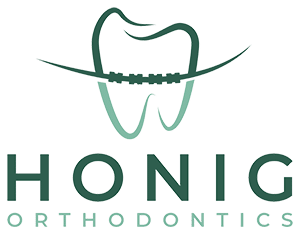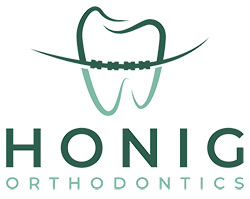Initial Visit
Do you charge for an initial visit?
No. As a courtesy to you and your family dentist, we will always discuss the feasibility of braces or tooth straightening without charging a fee.
At what age do you start seeing patients?
As a rule of thumb, we like to evaluate young patients after the 6-year molars erupt and the front permanent teeth just start to appear. This is usually between the ages of 6 and 8.
Why do you evaluate patients so young?
The purpose of early evaluation is to inform and observe, more than to start treatment. At this early age, the eventual needs may be identified and discussed. A small percentage of this young group may need some form of intervention. Habits are evaluated, medical issues are discussed and an observation schedule is arranged.
How long will the first visit take?
The first visit can last anywhere between 30 minutes and 1 hour depending on how ready the patient is for treatment. We may just do a visual exam and explain the situation or we may suggest one or more X-rays and complete diagnostics including casts of the teeth with photographs.
Do you take patients transferring from out of town?
Yes we do. We handle a patient transferring into our office from another city just like a new patient. We gather complete diagnostic records to show the current status and propose treatment to complete the work that has been started. Unlike most practices, we do not ask for a large down payment but merely assess a monthly fee to complete the treatment in progress.
Do you have any adult patients?
Absolutely. A growing percentage of our patients are adult. New, more cosmetic appliances are making adult treatment much more comfortable and convenient.
What is the difference between an orthodontist and a dentist?
An orthodontist is a general dentist that has had at least 2 more years of full-time training in orthodontics resulting in a nationally accepted specialty certificate. The orthodontist then limits his or her practice to straightening teeth and correcting jaw problems.
Can I make all my appointments in the afternoon after school and late in the day?
In order to have early and late appointments available for the majority of patients, some procedures need to be accomplished during the hours of 9 and 3. We will do our best to work with your schedules and accommodate your family needs.
Do you see patients for emergencies?
Yes, our contact information for an emergency is posted on the website as well as the phone answering machine.
Financial
Can we make payments?
Yes. Whether or not you have insurance or a dental plan, we will structure a convenient payment plan that will allow you to pay for necessary services over a period of time that usually coincides with your treatment plan.
How do you handle insurance?
After verification of coverage, we will agree to bill and collect from an insurance carrier. However, we ask patients to understand that if coverage ceases or changes, the patient is still responsible for the agreed upon fee.
Do you take American Express, Master Card and/or Visa?
Yes, we accept all major credit cards.
Do you have direct debit?
Yes, we have arrangements for direct debit, charge card posting, as well as payments over the internet.
Do you charge interest?
No we do not.
Do you give family discounts?
We have special programs and fees for multiple patients from the same family.
Types of Treatment
What is Phase 1 Treatment?
Phase 1 treatment is delivered early and before all permanent teeth have erupted. The purpose of this early care is to start correcting harmful malocclusions or poor bites that may be more difficult to correct later. Phase 1 treatment does not eliminate the need for conventional orthodontics done during adolescence. Examples of phase 1 treatment include correcting individual tooth or jaw crossbites and severe underbites and overbites where functional, aesthetic or psychological concerns are identified.
What is Phase 2 Treatment?
Phase 2 treatment is conventional orthodontic treatment. It may start while the last baby teeth are falling out and continue until the 12 year molars have been evaluated or straightened. This treatment usually lasts between 2 and 3 years.
How do I know if Phase 1, 2 or both type of treatments are necessary?
An early visit is suggested. About 10 to 20 percent of young patients may benefit from phase 1 treatment. Most other patients are observed until the appropriate time to initiate care.
Moving of Teeth (Mechanics)
I need to be pre-medicated for the dentist. Do I need to take my medicine for the orthodontist?
Yes, we follow any recommendation made by your physician.
How long do braces take?
Complete treatment can usually be accomplished in 2 years of active tooth movement. Sometimes, this active movement is divided into two or more periods of time with a rest of 6 to 18 months in between. (See phase 1 and 2 treatment above).
How do braces work?
Quite simply, crooked teeth are gradually moved into desired positions by taking shaped wires and attaching them to brackets on the teeth.
Retainers
Do retainers need to be worn after braces?
Yes, retainers are worn at nighttime indefinitely.
Why do teeth get crooked after wearing braces or aligners?
Teeth move throughout life whether you have worn braces or not. It is part of the natural aging process. This is why retainer wear is recommended indefinitely to maintain your orthodontic results over a lifetime.
How about retainers glued to the backs of teeth?
For some patients, permanent retainers are attached to the back of front teeth to keep them in place. This requires special hygiene procedures and regular recalls to the family dentist.
Wisdom Teeth (Third Molars)
Do wisdom teeth cause teeth to get crooked?
No, research has shown this not to be true.
Why do wisdom teeth need to be removed?
Wisdom teeth do not cause crooked teeth but they can cause gum problems, swelling if impacted, and trap food below the gum tissue causing infection. It is much nicer to plan for their removal rather than have them removed under emergency conditions.
When is a good time to have wisdom teeth removed?
The best time according to oral surgeons is when approximately 2/3 or so of the root is formed. Some time after age 16 or 18 seems to be the average.
Can braces or orthodontic treatment treat or cause TMJ problems?
Scientific literature has documented that there is not a direct link between orthodontic treatment or occlusion and TMJ. Problems with TMJ can be present or absent in the presence of all types of good and bad bites.
Health Impact
What are the health benefits of wearing braces?
Orthodontics helps to improve the comfort of the bite, make it easier to brush and floss your teeth for good dental health, and many times helps to balance the facial musculature. The positive self-esteem benefits are immeasurable.
How do enlarged adenoids and allergies affect braces?
Mouth breathing, as a result of enlarged adenoids or tonsils or allergies, may cause your upper and lower jaws to grow apart and elongate facial form during growth, resulting in crowding and often narrow arches.
How does a tongue thrust or low tongue posture affect braces?
The effects are similar to enlarged adenoids. Plus, the pressure on front teeth from the tongue thrusting can aggravate protrusion and spacing.

